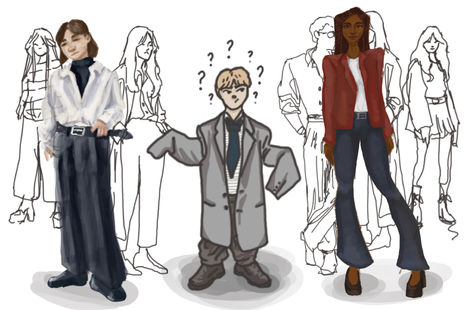What the f*ck is smart casual?
After dipping his toe into the world of employment, Wilf Vall reflects on why working dress codes are so hard to get right.

For me, dress codes have always been something of a novelty. Before coming to Cambridge I had worn a suit all of two times, and unlike many of my unfortunate peers, my sixth form had no real standards of what to wear. Our head of sixth form once claimed “If you can’t get arrested for it, you’re probably fine to wear it here”. Smart dressing in Cambridge has therefore been something pretty new to me, and has managed to be both confusing and exciting all at once. Tackling black tie for May balls, or picking out a tie for matriculation has gone from something I’d sneer at as snobbish to a challenge I relish.
There is, however, one of the new dress codes I’ve had to tackle since coming to Cambridge that has left me confounded by its vagaries: smart casual.
My most recent encounter with smart casual was on a work experience placement at a newspaper. Excitedly reading my email and looking forward to what lay ahead in my day of journalistic fun, my mood quickly soured as I read the dreaded words “Dress code: smart casual, no jeans or trainers”. Any anticipation I had about the placement quickly turned to panic as my mind fixated on the simple fact that I hadn’t a clue what smart casual actually was.
This was a serious problem. Those who’ve seen me hurrying around Sidge late to a lecture will know that jeans and trainers are essentially my second skin, and my non-casual assortment of clothes is made up of the same suit I wear to every formal, eBay-bought black tie. Google wasn’t much help either, with image results of “smart casual” looking like someone had hit randomise on the H&M menswear section, seemingly ranging from swimwear to a three-piece suit. Words like “slacks” and “dressy” made life more confusing, and just further convinced me that even fashion journalists don’t know what smart casual is. With a couple of hours to burn before my train, I resorted to my go-to strategy for any clothing crisis: a charity shop raid. Twelve quid and three shops later, I had successfully assembled my best attempt at emulating the dress sense of a supply teacher on the verge of a mid-life crisis.
“I had successfully assembled my best attempt at emulating the dress sense of a supply teacher on the verge of a mid-life crisis”
Upon arriving at the office I was trying to blend into, I was dismayed to find that everyone seemed to have effortlessly pulled off smart casual, and how little they seemed to care about it. It made sense, considering their workplace demanded it, but it didn’t address my nagging paranoia that I had failed at the dress code, and nobody was telling me. In a moment of desperation, upon meeting a friend for lunch I immediately blurted out, “Do you think I’ve done smart casual right?” before we’d even sat down. They smirked, and to my dismay commented on how it was “alright,” but that I looked “a little like a schoolteacher”. With those words my world came crashing down, I had failed to crack the enigma (dress) code once again.
This wasn’t my first duel with smart casual; a JCR committee lunch with our college master had provided a similar humiliation. I learnt of the dress code 20 minutes before the event started and, in a panicked fit, raided my neighbour’s wardrobe for anything that could be classed as smart casual. Once again, upon asking if I’d done it right a JCR colleague said “I think you’ve overdone it,” and “you look a little too much like a city banker”.
At this lunch I tried to get to the bottom of my plight with smart casual, asking a friend at the end of the event how he’d so easily pulled it off. He responded with a confused smirk and said “When we do family dinners we always dress up nice, so I just wore what I do then”. Of course. The answer was as obvious and quintessentially Cambridge as I could imagine. At the end of the day, what average teenager owns anything that fits into the bracket of smart casual when the only time it is needed is a prom or wedding. The only students who understood smart casual did so through virtue of their upbringing, acting as another reminder of all the barriers that exist for students who come from a “class act” (read: normal) background.
“The only students who understood smart casual did so through virtue of their upbringing”
In a world where we’re constantly reminded how much first impressions matter, dress codes as opaque as “smart casual” (or business casual, don’t get me started on that one), act as barriers to those who don’t understand them. It’s just another one of the endless dimensions of imposter syndrome so many Cambridge students face. Unlike black tie or formal wear, which are easy enough to decode with a quick Google, the opacity of smart casual acts as a barrier to equality and a potential cause of humiliation to anyone who doesn’t understand it.
 News / Pembroke to convert listed office building into accom9 December 2025
News / Pembroke to convert listed office building into accom9 December 2025 News / Gov declares £31m bus investment for Cambridge8 December 2025
News / Gov declares £31m bus investment for Cambridge8 December 2025 Features / Searching for community in queer Cambridge10 December 2025
Features / Searching for community in queer Cambridge10 December 2025 News / Uni redundancy consultation ‘falls short of legal duties’, unions say6 December 2025
News / Uni redundancy consultation ‘falls short of legal duties’, unions say6 December 2025 Lifestyle / Into the groove, out of the club9 December 2025
Lifestyle / Into the groove, out of the club9 December 2025










